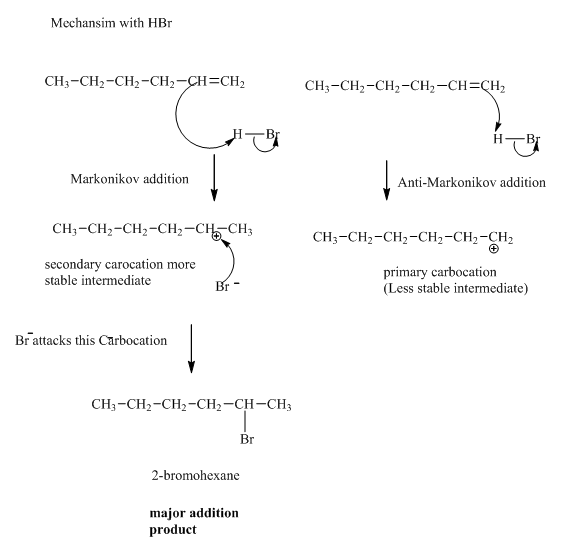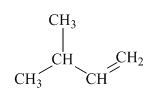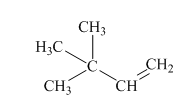
(a)
Interpretation:Mechanism for the reaction of hydrogen bromide with alkene indicated should be written.

Concept introduction:

(b)
Interpretation:Mechanism for the reaction of hydrogen bromide with alkene indicated should be written.

Concept introduction:Alkenes are considered electron rich and undergo addition reaction in presence of electrophilic halo acids. The product formed is governed by Markovnikov’s Rule. Rule suggests that negative part of halo acid HX must go to the carbon that has more alkyl substituents or less
(c)
Interpretation:Mechanism for the reaction of hydrogen bromide with alkene indicated should be written.

Concept introduction:In electrophilic addition reaction the product formed is governed by Markovnikov’s Rule. Rule suggests that negative part of halo acid HX must go to the carbon that has more alkyl substituents or less
Want to see the full answer?
Check out a sample textbook solution
Chapter 10 Solutions
EBK EXPERIMENTAL ORGANIC CHEMISTRY: A M
- Reaction of -pinene with borane followed by treatment of the resulting trialkylborane with alkaline hydrogen peroxide gives the following alcohol. Of the four possible cis,trans isomers, one is formed in over 85% yield. (a) Draw structural formulas for the four possible cis,trans isomers of the bicyclic alcohol. (b) Which is the structure of the isomer formed in 85% yield? How do you account for its formation? Create a model to help you make this prediction.arrow_forwardQ9:- Outline a possible laboratory, synthesis of each of the following compounds from benzene and/or toluene, using any needed aliphatic and inorganic reagents, (a) m-bromophenol (b) 5-bromo-2-methylphenol Q10:- Explain how Esters are more reactive than amides in nucleophilic acyl substitution reactions.arrow_forward(a) Tsomane and Nyiko were given a task of synthesising methylenecyclohexane 2. After a brief discussion with each other, Tsomane proposed Method A to synthesise 2 from cyclohexanone 1 while Nyiko proposed Method B that started from hydroxymethylcyclohexane 3. Each student believed that their proposed method is better than the other. (Scheme below) (1) Ph Ph 8*8 Ph THF A 1 Santande B H₂SO4 100 °C 3 OH Using curly arrows, provide full mechanistic details accounting how methylenecyclohexane 2 was synthesised according to both Methods A and B.arrow_forward
- (i) With the aid of diagrams discuss bonding for the carbonyl group. Your answer should reference hybrid atomic orbitals, show sigma - and pi -bonds and give bond angles. (ii) Explain the relevance pi antibonding *-molecular orbitals have in nucleophilic addition reactions of carbonyl containing compoundsarrow_forwardVII. 1-bromo-3-methyl-2-butene undergoes nucleophilic substitution reaction in both ethanol and sodium ethoxide/DMSO mixture. (1) Please write all organic substitution products for each of the two reactions, if two products are formed in a reaction, assign the major product, assuming that the reaction is under kinetic control (2) What is the most likely mechanism for each reaction? (giving the name of mechanism is sufficient).arrow_forwardUsing the following chemical analyses below, obtain the probable structure of the following hydrocarbon compound. Provide probable structure of the compound. Provide a probable structure of the compound. Support using the chemical structures obtained from the ozonolysis, hydroboration-oxidation, and hydrogenetion.arrow_forward
- In each of the following electrophilic substitution reactions (i) as a first step show the“preactivation” or generation of an electrophilic species; (ii) using arrows provide a mechanisticexplanation of the course of the reaction (show all resonance structures contributing for intermediatearenium ion stabilization); (iii) write all major products of the reaction Friedel-Crafts monoalkylation of 1,3-dimethylbenzene with tert-butyl chloride in thepresence of FeCl3 as a catalyst.arrow_forward3. Alkene Reactions - Give the structure of the major organic product formed in the reaction of 3,3-dimethyl-1-butene with each of the following: (a) hydrogen chloride (b) hydrogen bromide duct for the (c) dilute acid (H3O+) (d) BH3 in THF, followed by H2O2, OH- (e) Hg(OAc)2 in H2O, followed by NaBH4 (f) Br2 in CH2Cl2 (g) Br2 in H2O (h) mCPBA followed by H3O+ (i) O3, followed by Zn, H₂Oarrow_forwardChoose from the options A-E and explain briefly by illustrations the chemistry behind each answer. Preamble: A reaction flask contains a 2-bromopentane in an ethanolic solution of sodium ethoxide at room temperature and results in the formation of two olefinic 1.All the following parameters would affect the rate and kinetics of the reaction exceptA.Solvent mediumB.Reaction temperatureC.Reaction timeD.Geometry and structure of the alkyl halideE.pH 2.What would be the major product when 2-iodopentane is involved in a dehydrohalogenation reaction? A.2-iodo-1-penteneB.2-penteneC.(E)-2-penteneD.(Z)-2-penteneE.Cis-2-pentenearrow_forward
- Synthesize the following compound from benzonitrile (C6H5CN):? Please don't provide hand written solution....arrow_forward12:53 ul 4G O 2. Show a reaction scheme with all the reactants and reagents of the nitration reaction of bromobenzene and show the major products(s), with valid reasons motivate why the positioning of the two constituents' favour ortho, para and/or meta positioning Add a caption... > Status (Custom) +arrow_forward(a) Tsomane and Nyiko were given a task of synthesising methylenecyclohexane 2. After a brief discussion with each other, Tsomane proposed Method A to synthesise 2 from cyclohexanone 1 while Nyiko proposed Method B that started from hydroxymethylcyclohexane 3. Each student believed that their proposed method is better than the other. (Scheme below) Ph THF A Ph Ph B H₂SO4 100 °C 3 OH (iii) In analysing both these methods, are there other possible alkene products other than methylenecyclohexane 2? Use mechanistic details to support your answer.arrow_forward
 Organic ChemistryChemistryISBN:9781305580350Author:William H. Brown, Brent L. Iverson, Eric Anslyn, Christopher S. FootePublisher:Cengage Learning
Organic ChemistryChemistryISBN:9781305580350Author:William H. Brown, Brent L. Iverson, Eric Anslyn, Christopher S. FootePublisher:Cengage Learning
